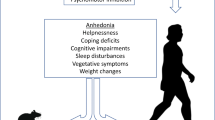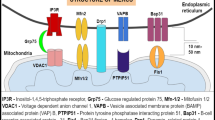Abstract
Previous studies revealed that patients with post-traumatic stress disorder (PTSD) have a smaller than normal medial prefrontal cortex (mPFC), and PTSD rats [single prolonged stress, (SPS)] have an increased mPFC neuron apoptosis, which are related to the severity of PTSD symptoms. Three signalling pathways [protein kinase RNA-like endoplasmic reticulum kinase (PERK), activating transcription factor 6 (ATF6), and inositol-requiring enzyme 1 (IRE1)] in the endoplasmic reticulum (ER) play a critical role in resisting apoptosis. The aim of this study was to investigate whether the three branches of ER signalling are involved in SPS-induced mPFC neuron apoptosis. We used transmission electron microscopy (TEM) to detect morphological changes in ER and fluorescence spectrophotometry to detect the concentration of intracellular calcium in mPFC. We used molecular biological techniques to detect the expression levels of three branch signalling pathways of ER: phosphorylated PERK (p-PERK)/phosphorylated eukaryotic translation initiation factor 2A (p-eIF2a), ATF6a/X-box binding protein 1 (XBP1), and IRE1a. In addition, the ER molecular chaperone 78-kDa glucose-regulated protein (GRP78) and the ER-related apoptosis factors caspase family and Bax also were examined. Apoptosis neurons were detected by terminal deoxynucleotidyl transferase deoxyuridine triphosphate nick end labeling. The results showed that the concentration of calcium in mPFC was increased in SPS rats. Using TEM, we found that mPFC neurons in SPS rats showed an expanded ER and chromatin margination. The increased expressions of p-PERK/p-eIF2a, ATF6a/XBP1, and IRE1 in response to SPS were also observed, although the degrees of increase were different. In addition, the protein and mRNA expression of GRP78 was increased in SPS rats; the upregulation of ER-related apoptosis factors and apoptosis neurons after SPS stimulation was observed. These results suggested that the three signalling pathways of unfolded protein response were involved in PTSD-induced, ER-dependent apoptosis in mPFC.









Similar content being viewed by others
References
American Psychiatric Association (2013) Diagnostic and statistical manual of mental disorders, 5th edn. American Psychiatric Association, Arlington
Arruda-Carvalho M, Clem RL (2015) Prefrontal-amygdala fear networks come into focus. Front Sys Neurosci 9:145
Bell MC, Meier SE, Ingram AL, Abisambra JF (2016) PERK-opathies: an endoplasmic reticulum stress mechanism underlying neurodegeneration. Curr Alzheimer Res 13(2):150–163
Bremner JD (2007) Neuroimaging in posttraumatic stress disorder and other stress-related disorder. Neuroimaging Clin N Am 17(4):523–538
Chang RC, Wong AK, Ng HK, Hugon J (2002) Phosphorylation of eukaryotic initiation factor-2alpha (eIF2alpha) is associated with neuronal degeneration in Alzheimer’s disease. Neuroreport 13:2429–2432
Chen Y, Brandizzi F (2013) IRE1: ER stress sensor and cell fate executor. Trends Cell Biol 23(11):547–555
Ding JL, Han F, Shi YX (2010) Single-prolonged stress induces apoptosis in the amygdala in a rat model of post-traumatic stress disorder. J Psychiatr Res 44:48–55
Frick KM, Baxter MG, Markowaska AL, Olton DS, Price DL (1995) Age-related spatial reference and working memory deficits assessed in the water maze. Neurobiolo Aging 16:149–160
Fu Y, Li J, Lee AS (2007) Grp78/bip inhibits endoplasmic reticulum bik and protects human breast cancer cells against estrogen starvation-induced apoptosis. Cancer Res 67:3734–3740
Gao H, Yan P, Zhang S, Nie S, Huang F, Han H, Deng Q, Huang Q, Yang W, Wu H, Yao P, Ye K, Xu JM, Liu L (2015) Chornic alpha-linolenic acid treatment alleviates age-associated neuropathology: roles of PERK/eIF2a singling pathway. Bran Behav Immun. Pil:S0889-1591(15)30019-2. doi:10.1016/j.bbi.2015.09.012. [Epub ahead of print] [PubMed: 26399745]
Han F, Yan S, Shi Y (2013) Single-prolonged stress induces endoplasmic reticulum-dependent apoptosis in the hippocampus in a rat model of post-traumatic stress disorder. PLoS ONE 8(7):e69340
Harding HP, Zhang Y, Ron D (1999) Protein translation and folding are coupled by an endoplasmic-reticulum-resident kinase. Nature 397:271–274
Harding HP, Zhang Y, Bertolotti A, Zeng H, Ron D (2000) Perk is essential for translational regulation and cell survival during the unfolded protein response. Mol Cell 5:897–904
Hashida K, Kitao Y, Sudo H, Awa Y, Maeda S, Mori K, Takahashi R, Iinuma M, Hori O (2012) ATF6 alpha promotes astroglial activation and neuronal survival in a chronic mouse model of Parkinson’s disease. Plos one 7(10):e47950
Haze K, Yoshida H, Yanagi H, Yura T, Mori K (1999) Mammalian transcription factor ATF6 is synthesized as a transmembrane protein and activated by proteolysis in response to endoplasmic reticulum stress. Mol Biol Cell 10:3787–3799
Hull AM (2002) Neuroimaging findings in post-traumatic stress disorder systematic review. Br J Psychiatry 181:102–110
Jiang ZQ, Ma YX, Li MH, Zhan XQ, Zhang X, Wang MY (2015) 5-Hydroxymethylfurfural protects against ER stress-induced apoptosis in GalN/TNF-α-injured L02 hepatocytes through regulating the PERK-eIF2α signaling pathway. Chin J Nat Med 13(12):896–905
Kaufman RJ, Scheuner D, Schroder M, Shen X, Lee K, Liu CY, Arnold SM (2002) The unfolded protein response in nutrient sensing and differentiation. Nat Rev Mol Cell Biol 3:411–421
Kebache S, Cardin E, Nguyen DT, Chevet E, Larose L (2004) Nck-1 antagonizes the endoplasmic reticulum stress-induced inhibition of translation. J Biol Chem 279:9662–9671
Klein B, Mitchell J, Gilson K et al (2009) A therapist-assisted Internet-based CBT intervention for posttraumatic stress disorder: preliminary results. Cogn Behav Ther 38(2):12–31
Li Y, Han F, Shi Y (2013) Increased neuronal apoptosis in medial prefrontal cortex is accompanied with changes of Bcl-2 and Bax in a rat model of post-traumatic stress disorder. J Mol Neurosci 51(1):127–137
Li XY, Han F, Shi YX (2015) IRE1a-XBP1 pathway is activated upon induction of single-prolonged stress in rat neurons of the medial prefrontal cortex. J Mol Neurosci 57:63–72
Liberzon I, Martis B (2006) Neuroimaging studies of emotional responses in PTSD. Ann NY Acad Sci 1071:87–109
Lin ML, Chen SS, Huang RY, Lu YC, Liao YR, Reddy MV, Lee CC, Wu TS (2014) Suppression of PI3K/Akt signaling by synthetic bichalcone analog TSWU-CD4 induces ER stress- andBax/Bak-mediated apoptosis of cancer cells. Apoptosis 19(11):1637–1653
Majd S, Power JH, Grantham HJ (2015) Neuronal response in Alzheimer’s and parkinson’s disease: the effect of toxic proteins on intracellular pathways. BMC Neurosci 16:69
Merrick WC (2004) Cap-dependent and cap-independent translation in eukaryotic systems. Gene 332:1–11
Mesitov MV, Moskovtesev AA, Kubatiev AA (2013) Molecular logic of the endoplasmic reticulum stress signal pathway: the system of unfolded protein response. Patol Fiziol Eksp Ter 4:97–108
Mitsuda T, Omi T, Tanimukai H, Sakagami Y, Tagami S, Okoxhi M, Kuso T, Takeda M (2011) Sigma-1Rs are upregulated via PERK/eIF2a/ATF4 pathway and execute protective function in ER stress. Biochem Biophys Res Commun 415(3):519–525
Morey RA, Haswell CC, Hooper SR, De Bellis MD (2015) Amygdala, hippocampus, and ventral medial prefrontal cortex volumes differ in maltreated youth with and without chronic posttraumatic stress disorder. Neuropsychopharmacology 41(3):791–801
Morris R (1984) Developments of a water-maze procedure for studying spatial learning in the rat. J Neurosci Methods 11:47–60
Ranganathan AC, Zhang L, Adam AP, Aguirre-Ghiso JA (2006) Functional coupling of p38-induced up-regulation of bip and activation of rna-dependent protein kinase-like endoplasmic reticulum kinase to drug resistance of dormant carcinoma cells. Cancer Res 66:1702–1711
Rao RV, Hermel E, Castro-Obregon S, del Rio G, Ellerby LM, Ellerby HM, Bredesen DE (2001) Coupling endoplasmic reticulum stress to the cell death program. Mechanism of caspase activation. J Biol Chem 276:33869–33874
Rao RV, Peel A, Logvinova A, del Rio G, Hermei E, Yokota T, Goldsmith PC, Ellerby LM, Ellerby HM, Bredesen DE (2002) Coupling endoplasmic reticulum stress to the cell death program: role of the ER chaperone GRP78. FEBS Lett 514:122–128
Raven JF, Baltzis D, Wang S, Mounir Z, Papadakis AI, Gao HQ, Koromilas AE (2008) Pkr and pkr-like endoplasmic reticulum kinase induce the proteasome-dependent degradation of cyclin d1 via a mechanism requiring eukaryotic initiation factor 2alpha phosphorylation. J Biol Chem 283:3097–3108
Reddy RK, Mao C, Baumeister P, Austin RC, Kaufman RJ, Lee AS (2003) Endoplasmic reticulum chaperone protein grp78 protects cells from apoptosis induced by topoisomerase inhibitors: role of atp binding site in suppression of caspase-7 activation. J Biol Chem 278:20915–20924
Romisch K (2005) Endoplasmic reticulum-associated degradation. Annu Rev Cell Dev Biol 21:435–456
Sherin JE, Nemeroff CB (2011) Post-traumatic stress disorder: the neurobiological impact of psychological trauma. Dialogues Clin Neurosci 13:263–278
Shin LM, Orr SP, Carson MA, Rauch SL, Macklin ML, Lasko NB, Peters PM, Metzger LJ, Dougherty DD, Cannistraro PA, Alpert NM, Fischman AJ, Pitman RK (2004) Regional cerebral blood flow in amygdala and medial prefrontal cortex during traumatic imagery in male and female Vietnam veterans with PTSD. Arch Gen Psychiatry 6:168–176
Soto C (2003) Unfolding the role of protein misfolding in neurodegenerative diseases. Nat Rev Neurosci 4:49–60
Volgyi K, Juhász G, Kovacs Z, Penke B (2015) Dysfunction of endoplasmic reticulum(ER) and mitochondria(MT) in Alzheimer’s disease: the role of the ER-MT cross-talk. Curr Alzheimer Res 12(7):655–672
Wang HT, Han F, Shi YX (2009) Activity of the 5-HT1A receptor is involved in the alteration of glucocorticoid receptor in hippocampus and corticotrophin-releasing factor in hypothalamus in SPS rats. Int J Mol Med 24:227–231
Wen L, Han F, Shi Y (2015) Changes in the glucocorticoid receptor and Ca2+/Calreticulin-dependent signaling pathway in the medial prefrontal cortex of rats with post-traumatic stress disorder. J Mol Neurosci 56(1):24–34
Xiao B, Yu B, Liu DJ, Han F, Shi YX (2015) Single prolonged stress induces dysfunction of endoplasmic reticulum in a rat model of post-traumatic stress disorder. Molecul Med Rep 12(2):2015–2020
Xu C, Bailly-Maitre B, Reed JC (2005) Endoplasmic reticulum stress: cell life and death decisions. J Clin Invest 115:2656–2664
Yoshida H, Matsui T, Yamamoto A, Okada T, Mori K (2001) XBP1mRNA is induced by ATF6 and spliced by IRE1 in response to ER stress to produce a highly active transcription factor. Cell 107:881–891
Yoshida H, Oku M, Suzuki M, Mori K (2006) pXBP1(U) encoded in XBP1 pre-mRNA negatively regulates unfolded protein response activator pXBP1(S) in mammalian ER stress response. J Cell Biol 172:565–575
Yu B, Wen LL, Xiao B, Han F, Shi YX (2014) Single prolonged stress induces ATF6 alpa-dependent endoplasmic reticulum stress and the apoptotic process in medial frontal cortex neurons. BMC Neurosci 15:115
Zelikowsky M, Hersman S, Chawla MK et al (2014) Neuronal ensembles in amygdala, hippocampus, and prefrontal cortex track differential components of contextual fear. J Neurosci 34(25):8462–8466
Zhang JH, Han F, Shi YX (2012) Single prolonged stress induces changes in the expression of mineralocorticoid receptor in the medial prefrontal cortex in a rat model of post-traumatic stress disorder. Molecul Med Rep 6:330–334
Zhao D, Han F, Shi Y (2014) Effect of glucose-regulated protein 94 and endoplasmic reticulum modulator CasPase-12 in medial prefrontal cortex in a ratmodel of posttraumatic stress disorder. J Mol Neurosci 54(2):147–155
Zong WX, Li C, Hatzivassiliou G, Lindstrn T, Yu QC, Yuan J, Thompson CB (2003) Bax and Bak can localize to the endoplasmic reticulum to initiate apoptosis. J Cell Biol 162(1):59–69
Acknowledgments
This study was supported by grants from the National Natural Science Foundation of China (No. 81571324;No.31200772) and Education Department of LiaoNing Province, China (No. LJQ2014083), What’ more, our feel grateful for technical support from the China Medical University Experiment Center. And our thanks professor Han Fang and professor Shi Yuxiu for guidance and discussion.
Author information
Authors and Affiliations
Corresponding author
Rights and permissions
About this article
Cite this article
Wen, L., Han, F., Shi, Y. et al. Role of the Endoplasmic Reticulum Pathway in the Medial Prefrontal Cortex in Post-Traumatic Stress Disorder Model Rats. J Mol Neurosci 59, 471–482 (2016). https://doi.org/10.1007/s12031-016-0755-2
Received:
Accepted:
Published:
Issue Date:
DOI: https://doi.org/10.1007/s12031-016-0755-2




